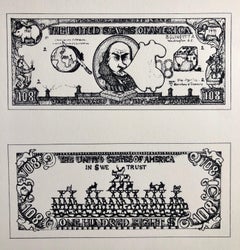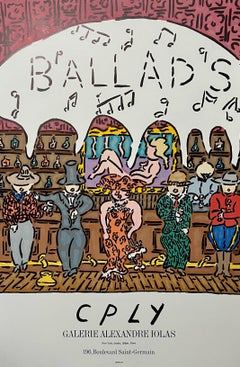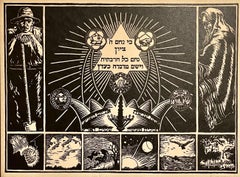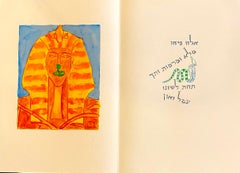Want more images or videos?
Request additional images or videos from the seller
1 of 12
Tony King80's Pop Art 20$ Bill Large Screenprint Tony King Silkscreen Lithograph Currency1981
1981
Price:$2,800
$3,600List Price
About the Item
- Creator:Tony King (1944, American)
- Creation Year:1981
- Dimensions:Height: 21 in (53.34 cm)Width: 41.5 in (105.41 cm)
- Medium:
- Movement & Style:
- Period:
- Condition:good, mounted to backing, can be easily unmounted. minor tear in bottom margin. can be easily matted out.
- Gallery Location:Surfside, FL
- Reference Number:1stDibs: LU38210212322
About the Seller
4.9
Platinum Seller
Premium sellers with a 4.7+ rating and 24-hour response times
Established in 1995
1stDibs seller since 2014
1,846 sales on 1stDibs
Authenticity Guarantee
In the unlikely event there’s an issue with an item’s authenticity, contact us within 1 year for a full refund. DetailsMoney-Back Guarantee
If your item is not as described, is damaged in transit, or does not arrive, contact us within 7 days for a full refund. Details24-Hour Cancellation
You have a 24-hour grace period in which to reconsider your purchase, with no questions asked.Vetted Professional Sellers
Our world-class sellers must adhere to strict standards for service and quality, maintaining the integrity of our listings.Price-Match Guarantee
If you find that a seller listed the same item for a lower price elsewhere, we’ll match it.Trusted Global Delivery
Our best-in-class carrier network provides specialized shipping options worldwide, including custom delivery.You May Also Like
Mini Fab - Pride, Limited edition print, Hand made print, Ice cream Art
By Gavin Dobson
Located in Deddington, GB
To celebrate 50 golden years of Pride UK. A special golden disco mix edition of one of my most popular pieces. 5 layer screen print on Heritage white. A celebration of colour and par...
Category
2010s Pop Art More Prints
Materials
Paper, Glitter, Mixed Media, Screen
$81
H 8.27 in W 5.83 in D 0.4 in
Yes You Can Can
Located in Deddington, GB
Yes You Can Can (Splats Edition) by Amy Gardner [2020]
limited_edition
Screen Print, Watercolour
Edition number 40
Image size: H:50 cm x W:50 cm
Sold Unframed
Please note that insitu images are purely an indication of how a piece may look
Only AP works left in this edition. This print is about women supporting women. 'YES YOU CAN CAN' splats edition limited edition of 40 Archival Bread & Butter bright white paper 270gsm 50x 50cms 5 screen...
Category
21st Century and Contemporary Pop Art Figurative Prints
Materials
Paper, Watercolor, Screen
"A Song for a Nesei Fisherman" Poster, Limited Edition Screenprint #14 of 100
Located in Soquel, CA
"A Song for a Nesei Fisherman" Poster, Limited Edition Screenprint #14 of 100
Show poster designed by Chester Yoshida (American, b. 1922). The play "A Song for a Nisei Fisherman" wa...
Category
1980s Pop Art Figurative Prints
Materials
Paper, Screen
$460 Sale Price
20% Off
H 30 in W 24 in D 0.25 in
Original Andy Warhol Brillo Pasadena Art Museum serigraph vintage poster
By Andy Warhol
Located in Spokane, WA
Original serigraph: Andy Warhol Brillo soap pads. Artist: Andy Warhol. Size 26" x 30" Year: 1970. Archival linen-backed original serigraph ready to frame.
Warhol's Billo ...
Category
1970s Pop Art Figurative Prints
Materials
Screen
$2,498
H 30 in W 26 in D 0.3 in
Mississippi, Serigraph from the American Dream Portfolio by Robert Indiana
By Robert Indiana
Located in Long Island City, NY
Artist: Robert Indiana, American (1928 - 2018)
Title: Mississippi from the American Dream Portfolio
Year: 1965 (1997)
Medium: Serigraph
Edition: 395
Image Size: 16 x 14 inches
Size: ...
Category
1960s Pop Art Figurative Prints
Materials
Screen
LOVE from the American Dream Portfolio by Robert Indiana
By Robert Indiana
Located in Long Island City, NY
Artist: Robert Indiana, American (1928 - 2018)
Title: Die Deutsche Liebe (The German LOVE) from the American Dream Portfolio
Year: 1968 (1997)
Medium: Silkscreen on Wove Paper
Editio...
Category
1960s Pop Art More Prints
Materials
Screen
"Number 7", Silkscreen from the American Dream Portfolio by Robert Indiana
By Robert Indiana
Located in Long Island City, NY
Artist: Robert Indiana, American (1928 - 2018)
Title: Number 7 from the American Dream Portfolio
Year: 1968 (1997)
Medium: Screenprint on Wove Paper
Edition Size: 395
Image Size: 16....
Category
1990s Pop Art More Prints
Materials
Screen
"Black Diamond", Silkscreen from the American Dream Portfolio by Robert Indiana
By Robert Indiana
Located in Long Island City, NY
Artist: Robert Indiana, American (1928 - 2018)
Title: Black Diamond from the American Dream Portfolio
Year: 1962 (1997)
Medium: Screenprint (unsigned)
Edition: 395
Image Size: 14 x 1...
Category
1960s Pop Art More Prints
Materials
Screen
$1,000
H 22 in W 17 in D 0.1 in
Flowers (Hand-Colored)
By Andy Warhol
Located in Washington, DC
Artist: Andy Warhol
Title: Flowers (Hand-Colored)
Medium: Screenprint hand-colored with watercolor on white wove paper
Date: 1974
Edition: 238/250
Sheet Size: 40 7/8" x 27 1/4"
Signa...
Category
1970s Pop Art Figurative Prints
Materials
Watercolor, Screen
THE BOOK OF LOVE SUITE (DELUXE)
By Robert Indiana
Located in Aventura, FL
Complete deluxe set of 13 screen prints and accompanying 12 poems. Published by American Image Editions, New York. Includes original brown paper-covered portfolio and publisher insert. Each screen print measures 26 x 21 inches. Each screen print is hand signed, dated, numbered by Robert Indiana. Roman numeral edition XLII/L (there were also a main edition of 200 and 50 artist's proofs),
Artwork is in excellent condition. Certificate of Authenticity included. All reasonable offers will be considered.
About the Artist: Robert Indiana (1928–2018) was an American Pop artist whose work drew inspiration from signs, billboards, and commercial logos. He is best known for his series of LOVE paintings, which employed bold and colorful letterforms to spell out the word “love.” “Oddly enough, I wasn't thinking at all about anticipating the love generation and hippies,” he once explained. “It was a spiritual concept. It isn't a sculpture of love...
Category
1990s Pop Art Figurative Prints
Materials
Paper, Screen
More From This Seller
View All1960's Pop Art Silkscreen Print 108$ Bill Inflation Hand Signed and Numbered
By Oyvind Fahlstrom
Located in Surfside, FL
Öyvind Axel Christian Fahlström (1928–1976) was a Swedish Multimedia artist.
Fahlström was born in Sao Paulo, Brazil, In July 1939 he was sent to Stockholm to visit some distant relatives and after World War II he started to study and later on to work as a writer, critic and journalist. From 1960 until 1976 he was married to the Swedish Pop Art painter Barbro Östlihn.
In 1953 Fahlström had his first solo exhibition, showing the drawing Opera, a room-sized felt-pen drawing. Also in 1953 he wrote Hätila ragulpr på fåtskliaben, a manifesto for concrete poetry, published in Swedish the following year and in English translation (by Mary Ellen Solt, in her anthology "Concrete Poetry. A world view") in 1968.
In 1956 Fahlström moved to Paris and lived there for three years before he moved to Front Street studio, New York City. In New York he worked with different artists and explored his role as an artist further. In 1962 he participated in the New Realists exhibition at the Sidney Janis Gallery, in New York City. His work was included in the 1964 Venice Biennale and he had a solo exhibition at Cordier & Ekstrom Inc., New York. In 1965 he joined the Sidney Janis Gallery.
In 1966 his work Performance of Kisses Sweeter Than Wine was included in 9 Evenings: Theatre and Engineering, organized by Experiments in Art and Technology at the 26th Street Armory, New York. The same year his painting in oil on photo...
Category
1970s Pop Art Figurative Prints
Materials
Lithograph, Screen
Vintage Galerie Alexandre Iolas Ballads Poster William Copley CPLY Mourlot Litho
Located in Surfside, FL
Ballads Galerie Alexandre Iolas Poster by William N. Copley (CPLY)
New-York, Geneve, Milan, Paris
196, Boulevard Saint-Germain
William Nelson Copley (January 24, 1919 – May 7, 1996) also known as CPLY, was an American painter, writer, gallerist, collector, patron, publisher and art entrepreneur. His works as an artist have been classified as late Surrealist and precursory to Pop Art.
William N. Copley was born in New York City in 1919 to parents John and Flora Lodwell; they died shortly after in the 1919 Spanish Flu epidemic. Copley was adopted in 1921 by Ira C. Copley, the owner of sixteen newspaper companies in Chicago and San Diego. Copley was ten years old whereby the family moved to Coronado Island, California.
Copley was sent to Phillips Andover and then Yale University by his adopted parents. He was drafted in the Second World War in the middle of his education at Yale, a decision negotiated by the school and the army. Copley experimented with politics upon returning home from the war, working as a reporter for his father's newspaper.
By 1946, Copley met and married Marjorie Doris Wead, the daughter of a test pilot for the Navy. Doris's sister was married to John Ployardt, a Canadian-born animator and narrator at Walt Disney Studios. Copley and Ployardt soon became friends and Ployardt began introducing Copley to painting and Surrealism. The two traveled to Mexico and New York, discovering art, meeting the artists behind the works, and grasping Surrealist ideas. It was during this time that Copley and Ployardt decided to open a gallery in Los Angeles to exhibit Surrealist works.
Copley and Ployardt tracked down Man Ray while living in Los Angeles. Ray then introduced them to Marcel Duchamp in New York City. There, Duchamp opened many doors for them, introducing the two to New York dealers in Surrealism. In 1948, Copley and Ployardt opened The Copley Galleries in Beverly Hills, displaying works by artists including René Magritte, Max Ernst, Yves Tanguy, Roberto Matta, Joseph Cornell, and Man Ray. Copley moved to Paris in 1949–50, leaving behind his wife and two children to continue to paint. During his time in Paris, he remained in Surrealist circles and continued to paint with a uniquely American style.
Copley's first exhibition took place in Los Angeles in 1951 at Royer's Book Shop. From there Copley participated in numerous solo and group exhibitions worldwide. In 1961, Copley was given an exhibition in Amsterdam by the Stedelijk Museum. The museum became the first public institution to add a Copley to their collection.
Copley's paintings throughout the 1950s and 60s dealt with ironic and humorous images of stereotypical American symbols like the Western saloon, cowboys, and pin-up girls combined with flags. His works during this period were often considered a combination of American and Mexican folk art and melded in well with the new young POP movement occurring in America when he returned to New York in the 1960s. Artists like Andy Warhol, Christo, Roy Lichtenstein and many others were frequent visitors at Copley's studio on Lower Broadway. Copley believed that pop art had always interested him, claiming American pop art had much to do with "self-disgust" and "satire."
In 1967, after a divorce with his second wife, Noma, Copley and new friend Dmitri Petrov decided to publish portfolios of 20th-century artist collaborations with the abbreviation SMS (for "Shit Must Stop"). Copley's Upper West Side loft became a meeting place for performers, artists, curators, and composers to work together on the open-ended collective. The SMS portfolio...
Category
20th Century Abstract Figurative Prints
Materials
Paper, Lithograph, Offset
Rare 1922 German Jewish Judaica Zion Woodcut Woodblock Print Hermann Fechenbach
By Hermann Israel Fechenbach
Located in Surfside, FL
Title: Zion
Subject: Various biblical images depicting Creation and prayer
1922
Medium: woodcut
Frame: 14" x 18"
Image: 12.5" x 16.75"
Provenance: owned and signed verso by Peter Keil.
Central panel shows the Jewish star over a crown, with inscription in Hebrew: "When God comforts Zion, He will comfort all its ruins and make its deserts look like Eden," and "You have sanctified the seventh day, the goal of creation of Heaven and Earth." This is flanked by a Palestinian farmer pioneer on the left and a Jew praying on the right. The lower tier shows six vignettes of the days of creation from Genesis.
Hermann Fechenbach was born in 1897 in Württemberg, Germany. He grew up in Bad Mergentheim where his parents had an inn, which served as a meeting place for the local Jewish community.
He left school early and through family connections with clothing retailers received training in window dressing. His skill with brush writing was quickly recognised by a big firm in Dortmund where he was responsible for the displays in 10 large windows. He received his conscription papers in 1916 and recalls “being as patriotic as any other fool”. In August 1917 he was involved in a grenade attack in which he was the sole survivor. With serious injuries to both legs he struggled to safety and was eventually transported to a front line “slaughterhouse” where the first of a series of amputations was performed which led to the loss of his left leg.
As a result of his injuries his father dropped his opposition to him becoming an artist. His formal art education started in 1918 with training at a Stuttgart handcraft school for invalids. He attended the Academies in Stuttgart and Munich to learn painting and restoration for 3 years. He was influenced at this time by Max Liebermann. He has been compared to Kathe Kollwitz and was a contemporary of Jakob Steinhardt and hermann Struck. In 1923 he went to Florence for a year. While in Florence he started to produce a series of miniature wood engravings to illustrate the stories of Genesis. This was followed by periods in Pisa, Venice, Vienna and Amsterdam. In 1924 he returned to Stuttgart to paint in the contemporary style “Die Neue Sachlichkeit”. (The New Objectivity was a movement in German art that arose during the 1920s Weimar republic as a reaction against expressionism. The term was coined by Gustav Friedrich Hartlaub, the director of the Kunsthalle in Mannheim, who used it as the title of an art exhibition staged in 1925 to showcase artists who were working in a post-expressionist spirit. These artists—who included Max Beckmann, Otto Dix, George Grosz, Christian Schad, Rudolf Schlichter and Jeanne Mammen) Every spring and autumn he exhibited at the “Kunstgebit” which served as the showcase for all serious artists of the period.
His professional status “Kunstmaler und Grafiker” was recognised by Berlin in 1926. Practically all his work from this period was sold following exhibition.
In 1926 he collaborated with an architect friend to build a bungalow in Hohenheim, a non-Jewish area and a suburb of Stuttgart. Hermann alternately lived in his country bungalow and his town studio, producing portraits for sale or barter and wood engravings for his own pleasure.
In 1930 he married a non-Jewish professional photographer – Greta Batze. They had a studio in Stuttgart, which was used to teach art to a group of 12 students.
In 1933 the Nazi influence removed his name from the official state register together with the right to exhibit. By spending most of his time in his bungalow out of the Jewish quarter the Fechenbachs escaped being registered by the Nazis for some years. They were ostracised and abused by their non-Jewish neighbours. Hermann made weekly visits to friends in town to teach them the practical skills they would need assuming they were to escape from Germany. His energies were directed towards protection and survival.
Ultimately the Nazi persecution forced the Fechenbachs to flee their homeland. They moved to Palestine for 3 months in 1938, but found the political and physical environment unsustainable.
Greta arrived in England penniless in January 1939 to work as a domestic servant and to find a guarantor for her husband. Hermann arrived in May 1939. They moved to Blackheath a few months later. Hermann resumed his painting and engraving as a means of earning a living. He raised enough money to get his parents out of Germany to join his brothers in Argentina but was unable to save his twin sister Rosa who died in a Nazi concentration camp. In 1940 Hermann was interned in Bury as a suspect alien. He protested about his treatment by starting a hunger strike. Because of his persistence he was moved to a prison in Liverpool. From Liverpool he was moved to the Hutchinson Camp in the Isle of Man with fellow artist Kurt Schwitters. Arrangements were made for Greta to be accommodated near by. While interned he commenced work on “Refugee Impressions”, a series of linocut prints (no wood was available).
In 1941 when released from internment the Fechenbachs came under the sponsorship of Dr. Bela Horovitz, the Austrian art publisher who in turn made an introduction to Professor Tancred Borenius.
They were offered lodgings with a family in Oxford. Hermann had his first public exhibition for many years in a small gallery in Oxford in 1942. A second exhibition of oils, pencil drawings, coloured linocut and woodblock prints held later in the year was opened by the mayor of Oxford and critically acclaimed.
In 1944 the first London exhibition took place at the Anglo-Palestinian club in Piccadilly. There were two exhibitions at the Ben Uri Art gallery during this period.
In 1948 a second exhibition at the Anglo Palestinian club was inaugurated by a member of the Rothschild family and several members of Parliament. This was a great success.
In 1944 the Fechenbachs moved to a top floor studio flat in Colet Gardens. Open exhibitions were held each Spring at the Embankment from 1946 to 1951. Movietone News produced a short feature on the artist, which was shown in cinemas in England and Germany.
In 1969 he published the Genesis story in a hard back volume containing 137 prints. He started to research the fate of the entire Jewish community of Bad Mergentheim during the period of the second world war, liaising with historian Dr. Paul Sauer and Professor Max Miller, historian and theologian. In 1972 Kohlhammer published his partly autobiographical book “The last Jews of Mergentheim”. He exhibited at the Anglo-Palestinian Club & the Ben Uri Gallery in the 1940s. His works only came to prominence during the last year of his life when he exhibited at Blond Fine Art.
Peter Keil part of the Junge Wilde. In 1978, the Junge Wilde painting style arose in the German-speaking world in opposition to established avant garde, minimal art and conceptual art. It was linked to the similar Transavanguardia movement in Italy, USA (neo-expressionism) and France (Figuration Libre). They were also known as the Neue Wilde. Artists included; Austria: Siegfried Anzinger, Erwin Bohatsch, Herbert Brandl, Gunter Damisch, Hubert Scheibl, Hubert Schmalix...
Category
1980s Impressionist Figurative Prints
Materials
Woodcut
Large Archival Pigment Print Judaica Lithograph Mark Podwal Jewish Hebrew Art
By Mark Podwal
Located in Surfside, FL
Mark Podwal (American, New York, born 1945)
"All This Has Come Upon Us"
Archival pigment print
Dimensions: 22 X 30 inches
Egyptian Orientalist image with Snake
From a 2014 portfol...
Category
21st Century and Contemporary Neo-Expressionist Figurative Prints
Materials
Lithograph, Archival Pigment
Large Archival Pigment Print Judaica Lithograph Mark Podwal Jewish Hebrew Art
By Mark Podwal
Located in Surfside, FL
Mark Podwal (American, New York, born 1945)
"All This Has Come Upon Us"
Archival pigment print
Dimensions: 22 X 30 inches
Temple Mount, Jerusalem, Israel
From a 2014 portfolio of...
Category
21st Century and Contemporary Neo-Expressionist Figurative Prints
Materials
Lithograph, Archival Pigment
Colorful Russian French Judaica Jewish Shtetl Wedding Lithograph Mourlot Paris
By Mane Katz
Located in Surfside, FL
Mane-Katz (1894-1962) Original Lithograph published by Andre Sauret, Monte Carlo, 1966, printed in France, by Mourlot. The ouvrage sheet is not included. this is from a limited editi...
Category
1960s Modern Figurative Prints
Materials
Lithograph
Still Thinking About These?
All Recently ViewedMore Ways To Browse
Vintage Baseball Game
80s Pop Art
John Wheeler
King Lear
Olympic 1976
Pedro Friedeberg Screen
Picasso Vollard Suite
Salvador Dali Signed Prints Horse
Superman Print
Three Graces Print
Tissot Etching
Vintage Guardian Angels
Vintage Skates
Vintage Sunflower Prints
Andre Dignimont
Basquiat 1983
Drunk Art
Edgar Degas Etching



